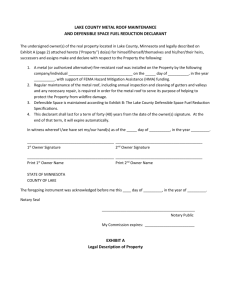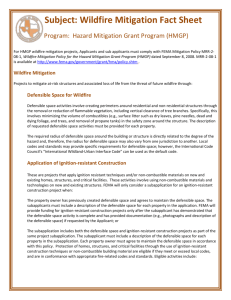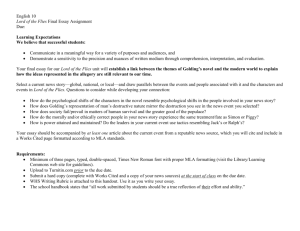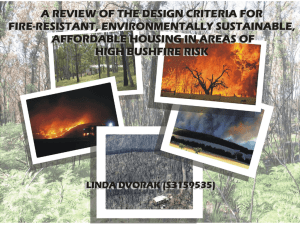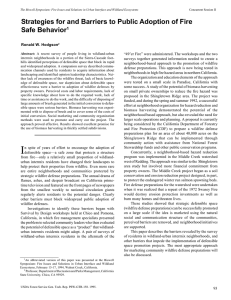A Handbook for Local Officials - Division of Homeland Security and
advertisement
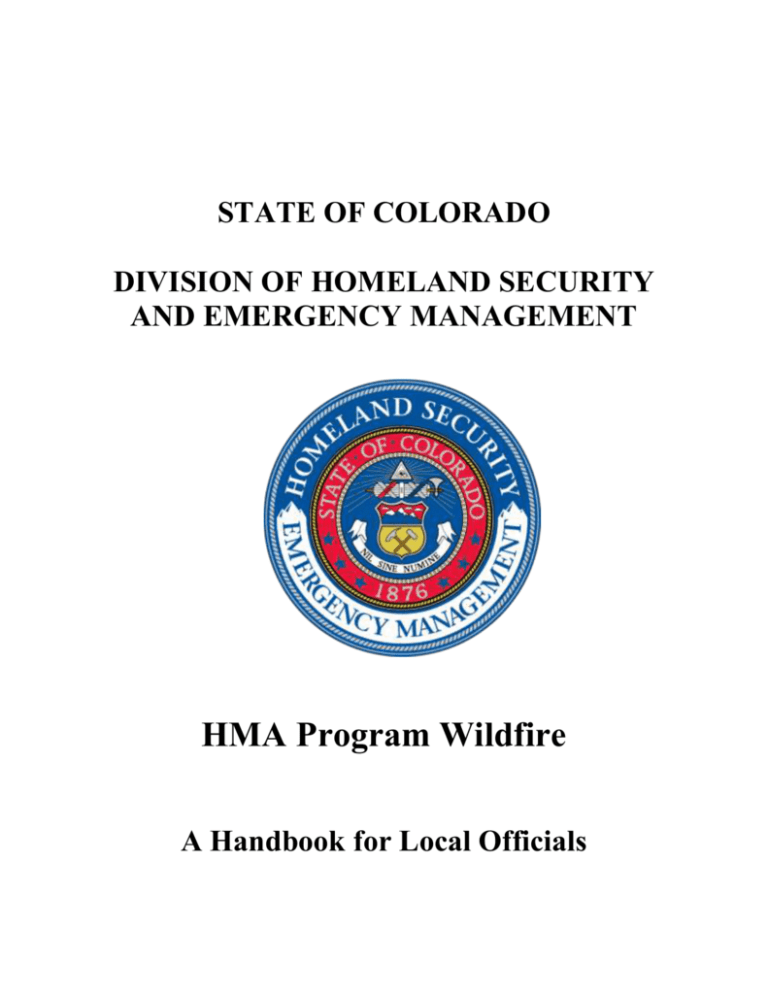
STATE OF COLORADO DIVISION OF HOMELAND SECURITY AND EMERGENCY MANAGEMENT HMA Program Wildfire A Handbook for Local Officials Defensible Space Creating defensible space involves creating a perimeter around a residential or non-residential building or structure by removing or reducing the volume of flammable vegetation including clearing tree branches vertically and horizontally. The volume of vegetation is minimized, flammable vegetation is replaced with less flammable species, and combustibles are cleared in accordance with all applicable codes and best practices. A description of the proposed defensible space activities must be provided for each property. FEMA recommends that ingress and egress to the building be maintained. Which of the following code standards and design criteria are used in your local codes? Please initial appropriate code or codes used. ________ ICC (International Code Council) ________ USFA (United Sates Fire Administration) ________ NFPA (National Fire Protection Agency) ________ FEMA (Federal Emergency Management Agency) ________ Other (e.g., Colorado State Forest Service: http://csfs.colostate.edu/pages/defensiblespace.html) The required radius of defensible space around a building is related to the degree of the hazard, and the radius that is needed for an effective defensible space may therefore vary from one jurisdiction or building to another. In addition, the topography, specifically slope steepness and direction, and the arrangement, amount, and flammability of the vegetation may require extending the perimeter. When the proposed perimeter extends beyond what is required, the effectiveness of the proposed defensible space must be demonstrated in the project application. It is recommended that the defensible space be broken up into three zones, with zone 1 being the zone in which the structure is located. For this program, a 100’ perimeter is required around the structure. Work completed beyond 100’ is considered to be forest health and is therefore not required and considered to be ineligible per HMA Guidance. Zone 1 (Within 30 feet of structure, required minimum) Zone 2 (From 31 feet to 100 feet of structure) APPLICANT ORGANIZATION SIGNATURE OF AUTHORIZED CERTIFYING OFFICIAL Zone 3 (Beyond 100 feet of structure) DATE SUBMITTED TITLE Hazardous Fuels Reduction Hazardous fuels reduction involves the removal or modification of vegetative fuels proximate to the at-risk buildings or structures that, if ignited, pose a significant threat to human life and property, especially critical facilities. Critical facilities include, but are not limited to, hospitals, fire stations, police stations, storage of critical records, and similar facilities. Hazardous fuels reduction projects are implemented at the community level and extend beyond defensible space perimeters. The maximum project radius is two miles from the structure(s) to be protected, provided said structure(s) meet or exceed applicable fire-related codes and standards. Does the proposed project protect one or more critical facilities? _____ Yes _____ No Which of the following hazardous fuels reduction methods will the applicant use? (Check all that apply) ________ Thinning of vegetation ________ Removing ladder fuels ________ Reducing flammable vegetative materials ________ Replacing flammable vegetative material with fire-resistant vegetation What technique will be used? _______ Chemical treatments, including herbicide applications _______ Mechanical treatments (disking, mulching, grinding, mowing, chopping) to include vertical and/or horizontal clearance of tree branches, and removal of the resulting materials (material left on-site must meet appropriate depth practice requirements) _______ Grazing or biomass conversion _______ Biomass removal including clearing of straw, removal of dead or dry vegetation, thinning, removal of brush & pine straw, and/or removing blown-down timber _______ Other industry-accepted techniques with FEMA’s approval The applicant hereby certifies that the proposed project is compliance with the requirements of Title 44 CFR §206.434(c) and will not take place on federal lands or supplant any other federal funding ICANT ORGANIZATION SIGNATURE OF AUTHORIZED CERTIFYING OFFICIAL awarded for the same purpose. DATE SUBMITTED TITLE Structural Protection through Ignition-Resistant Construction Structural protection through ignition-resistant construction involves the use of noncombustible materials, technologies, and assemblies on new and existing buildings and structures. FEMA will consider a subapplication for an ignition resistant-construction project only when: The property owner has previously created defensible space and agrees to maintain the defensible space in accordance with this guidance. The subapplicant must include documentation describing the defensible space for each property in the Application. FEMA will provide funding for ignition-resistant construction projects only after the subapplicant has demonstrated that the defensible space activity is complete and has provided documentation (e.g., photographs and description of the defensible space); or The subapplication includes both the defensible space and ignition-resistant construction projects as part of the same subapplication. The subapplicant must include a description of the defensible space for each property in the subapplication, and each property owner must agree to maintain the defensible space in accordance with this guidance. FEMA may fund above-code projects in communities if the project is cost-effective and in conformance with all applicable eligibility criteria. Please initial eligible activity used below: _____ Roof assemblies: Installation of roof coverings; roof sheathing; roof flashing; roof skylights; roof, attic, and wall vents; and roof eaves and gutters that conform to any of the following ignition-resistant construction standards: (1) construction materials are fire-resistant in accordance with nationally recognized testing standards, (2) construction materials are noncombustible, and (3) construction materials constitute an assembly that has a minimum 1hour -fire-resistant rating. _____ Wall components: Installation of wall components such as the fascia, windows, window glazing, doors, window frames, and insulation that conform to any of the following ignitionresistant construction standards: (1) construction materials are fire-resistant in accordance with nationally recognized testing standards, (2) construction materials are noncombustible, and (3) construction materials constitute an assembly that has a minimum 1-hour-fireresistant rating. Protection of fuel tanks (e.g., propane, gasoline). _____ External water hydration and thermal insulation systems: Purchase and installation of external, structure-specific water hydration and thermal insulation systems (foam, fireretardant, and water sprinkler systems) with a dedicated delivery system and dedicated selfcontained foam or retardant in sufficient volume to protect the structure. For water sprinklers, a cistern is acceptable if a dry hydrant with a fire department connection or other water source (e.g., lake, river, swimming pool) is available. SIGNATURE OF AUTHORIZED CERTIFYING OFFICIAL APPLICANT ORGANIZATION TITLE DATE SUBMITTED
